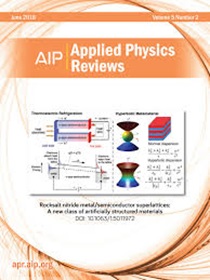金刚石中氮空位中心的核自旋寄存器增强量子传感
IF 11.6
1区 物理与天体物理
Q1 PHYSICS, APPLIED
引用次数: 0
摘要
近十年来,量子传感技术得到了快速发展,并从实验室向实际应用过渡。量子传感器的应用,从纳米技术到生物传感,预计将受益于量子传感器前所未有的空间分辨率和灵敏度。固体自旋系统是量子传感技术特别有吸引力的平台,因为室温操作是可行的,同时达到灵敏度的量子极限。在各种固体自旋系统中,金刚石中的氮空位(NV)中心显示出高保真初始化、相干控制和高对比度的电子自旋状态读出。然而,电子自旋相干性由于周围自旋槽的噪声和这种环境效应限制了NV中心的灵敏度。因此,基于NV中心的量子传感的关键任务是通过相干保护来提高灵敏度。针对这一任务,已经开发并实现了动态解耦技术、反馈控制和核自旋辅助传感协议等策略。在这些策略中,核自旋辅助协议显示出更大的电子自旋相干性增强。此外,金刚石中NV中心的电子和核自旋对自然允许核自旋辅助灵敏度增强方案的应用。由于核相干时间长,利用NV中心附近的活性核自旋(如14N, 13C)作为与NV中心耦合的记忆辅助,可以进一步提高灵敏度。本文综述了NV中心的自旋特性、核自旋辅助协议及其栅极变化机制,以及量子传感在高分辨率核自旋光谱、原子成像和磁场传感等领域的应用现状。我们讨论了商业化的潜力,目前在提高灵敏度方面面临的挑战,并总结了未来的研究方向,以促进核自旋辅助协议的发展及其融入工业应用。本文章由计算机程序翻译,如有差异,请以英文原文为准。
Quantum sensing enhancement through a nuclear spin register in nitrogen-vacancy centers in diamond
Quantum sensing has witnessed rapid development and transition from laboratories to practical applications in the past decade. Applications of quantum sensors, ranging from nanotechnologies to biosensing, are expected to benefit from quantum sensors' unprecedented spatial resolution and sensitivity. Solid-state spin systems are particularly attractive platforms for quantum sensing technologies because room temperature operation is viable while reaching the quantum limits of sensitivity. Among various solid-state spin systems, nitrogen-vacancy (NV) centers in diamond demonstrated high-fidelity initialization, coherent control, and high contrast readout of the electron spin state. However, electron spin coherence due to noise from the surrounding spin bath and this environment effect limits the sensitivity of NV centers. Thus, a critical task in NV center-based quantum sensing is sensitivity enhancement through coherence protection. Several strategies, such as dynamical decoupling techniques, feedback control, and nuclear spin-assisted sensing protocols, have been developed and realized for this task. Among these strategies, nuclear spin-assisted protocols have demonstrated greater enhancement of electron spin coherence. In addition, the electron and nuclear spin pair of an NV center in diamond naturally allows the application of the nuclear spin-assisted sensitivity enhancement protocol. Owing to long nuclear coherence times, further enhancement of sensitivity can be achieved by exploiting active nuclear spins (e.g., 14N, 13C) in the proximity of an NV center as memory ancillas when coupled with the NV center. Here, we review the spin properties of NV centers, mechanisms of the nuclear spin-assisted protocol and its gate variation, and the status of quantum sensing applications in high-resolution nuclear spin spectroscopy, atomic imaging, and magnetic field sensing. We discuss the potential for commercialization, current challenges in sensitivity enhancement, and conclude with future research directions for promoting the development of nuclear spin-assisted protocol and its integration into industrial applications.
求助全文
通过发布文献求助,成功后即可免费获取论文全文。
去求助
来源期刊

Applied physics reviews
PHYSICS, APPLIED-
CiteScore
22.50
自引率
2.00%
发文量
113
审稿时长
2 months
期刊介绍:
Applied Physics Reviews (APR) is a journal featuring articles on critical topics in experimental or theoretical research in applied physics and applications of physics to other scientific and engineering branches. The publication includes two main types of articles:
Original Research: These articles report on high-quality, novel research studies that are of significant interest to the applied physics community.
Reviews: Review articles in APR can either be authoritative and comprehensive assessments of established areas of applied physics or short, timely reviews of recent advances in established fields or emerging areas of applied physics.
 求助内容:
求助内容: 应助结果提醒方式:
应助结果提醒方式:


